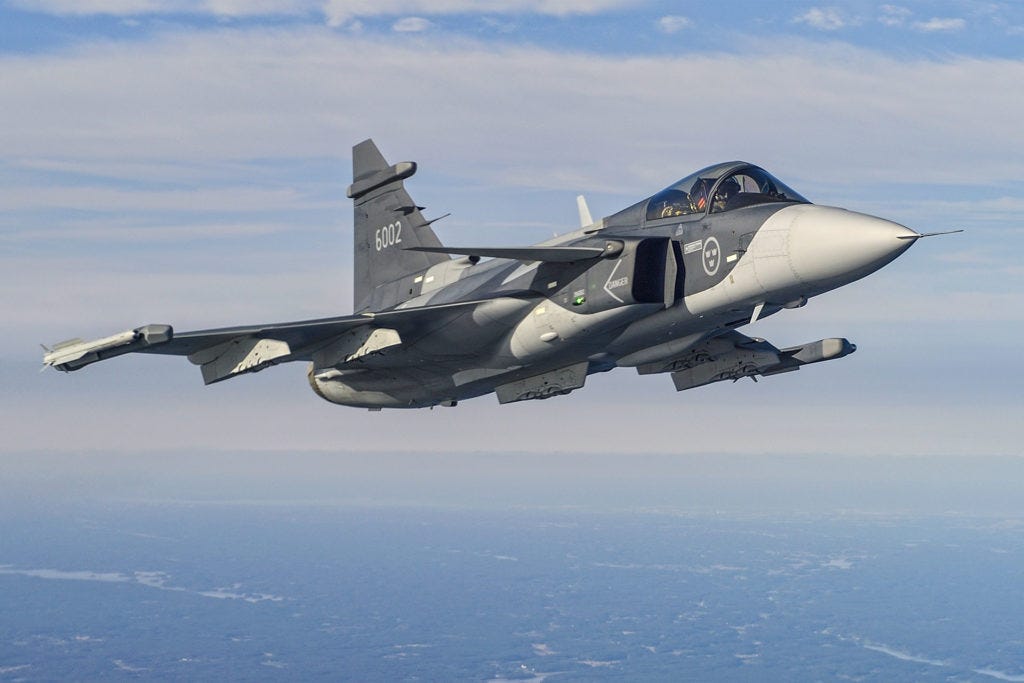Pipelines, Planes, and the Quiet Pivot East
Why Churchill, Gripens, and Carney’s “beyond pipelines” thinking could quietly redraw Canada’s energy map and the signals suggesting Canada’s next energy corridor won’t be built in BC.
Something curious is happening in Canadian energy politics. While the usual suspects argue over western routes, a different conversation is quietly taking shape—one that points north and east, toward Hudson Bay and Churchill, Manitoba.
The signals are subtle but worth noting.
Manitoba’s Bet on Churchill — and Carney
Wab Kinew’s enthusiasm for Prime Minister Mark Carney isn’t just provincial courtesy—it’s more like projection. Manitoba’s premier sees Churchill as central to his province’s economic future, and Carney has demonstrated exactly the kind of infrastructure-focused, capital-mobilization approach that major projects require.
The Prime Minister’s Major Projects Office, his $1 trillion investment strategy, his willingness to cut red tape for nation-building infrastructure—this is the policy environment where a Churchill energy corridor becomes viable.123
Carney’s recent comments that Canada needs to “think beyond pipelines” fit directly into this moment, signaling a shift from conventional energy corridors toward more imaginative strategic infrastructure.
Moe Signals Something Bigger
Scott Moe’s positioning is particularly telling. In February, Saskatchewan’s premier declared all pipeline permits in his province “pre-approved” — but crucially, he specified pipelines going “east, west, or south”. Not just west. Not just south to the United States. East was explicitly included.4
By October, Moe was backing Alberta’s western pipeline ambitions, calling it potentially the most significant generational infrastructure project Canada could consider. But just yesterday, his tone shifted slightly — he expressed hope for progress on a northern BC pipeline while acknowledging it wouldn’t be a “free-for-all” and that reasonable limits on tankers made sense given the environmentally sensitive coast.
Read between those lines. Moe isn’t abandoning the western route, but he’s keeping his options open. Saskatchewan benefits from any pipeline direction that moves product, and an eastern route through his province would deliver exactly that without the BC coastal politics. His explicit mention of eastern routes in February wasn’t throwaway language—it was strategic positioning.5
Alberta’s Calculated Quiet
Danielle Smith’s unusual silence is perhaps most telling. Alberta’s premier has never been shy about energy infrastructure—unless she’s calculating a different play. For two years she has loudly championed westward export capacity and repeatedly clashed with British Columbia over the political and regulatory barriers facing any new corridor through the Rockies. Yet on the question of eastern options, she has offered almost nothing publicly—no praise, no criticism, not even a test balloon.
In Alberta politics, silence is rarely accidental. Smith knows the western route is politically fraught, legally complex, and environmentally constrained. She also knows that if a prime minister with credibility on major project financing and national infrastructure starts building momentum toward Churchill, Alberta risks being left out of a corridor that could actually get built.
That raises the question: is Alberta quietly reassessing its map? Fighting British Columbia and the federal government over a west-coast route may no longer look like the optimal strategy when an eastern alternative—running through supportive provinces and avoiding BC’s tanker constraints—could move faster. And if Saskatchewan is already positioning itself as open to “east, west, or south,” Alberta cannot afford to appear inflexible.
Smith doesn’t need to endorse an eastern corridor. She only needs to keep her powder dry while she evaluates whether the future of Alberta’s export capacity might lie north and east rather than west. The fact that she hasn’t ruled it out is telling in itself.
BC Is Not in the Game
Elizabeth May remains adamant: no tankers on BC’s north coast, full stop. The Green Party leader has made this her line in the sand, and the political reality is that the Hecate Strait and Douglas Channel carry genuine environmental risks that resonate with coastal communities. This isn’t changing.678

David Eby appears entirely absent from this conversation. BC’s premier isn’t engaging on energy infrastructure in any meaningful way, which tells you where provincial priorities sit. British Columbia isn’t going to champion new pipeline capacity.
Churchill’s Business Case Strengthens
Meanwhile, the business case for Churchill is actually strengthening. The Port of Churchill’s viability has always been about volume—get enough throughput and the economics work. Arctic Gateway Group is scaling up critical mineral storage and freight along the Hudson Bay Railway, positioning Churchill as Canada’s only Arctic deep-water port with rail access linking western resources to global markets.9Canada’s new polar icebreakers, coming online this decade, fundamentally change Arctic shipping logistics and support longer, more reliable northern shipping seasons.1011
Longer shipping seasons mean more reliable export windows.
We’re watching a shift toward commerce-based Arctic sovereignty. Carney’s government isn’t just talking about the Arctic—it’s investing in it.[1] The focus on major projects, on economic transformation away from single-market dependence, on building Canadian industrial capacity—all of this creates the conditions where Churchill becomes a strategic economic hub rather than a remote port with marginal economics.
The Gripen Question and Arctic Sovereignty
Energy exports through Churchill reinforce Canadian presence in the North with economic activity, not just symbolic gestures or occasional military exercises. And if you’re serious about Arctic sovereignty, you need more than symbolic presence.
Which brings us to the Gripen question.
If Canada is serious about Arctic operations, we need aircraft that can operate from forward bases without extensive support infrastructure. Sweden’s Gripen was designed exactly for this—rapid deployment, minimal ground support, genuine cold-weather capability, proven performance operating from dispersed bases in harsh conditions.
Here’s where it gets interesting: a dual fighter procurement makes strategic and economic sense.
Gripens for Canadian Armed Forces Base Churchill and Iqaluit—dedicated Arctic sovereignty aircraft designed for exactly this mission profile. F-35s for southern bases like Bagotville, Cold Lake, and Comox—maintaining NORAD interoperability and NATO commitments where stealth and sensor fusion matter against peer adversaries.
Churchill as a Multi-Domain Hub
You’re not asking $100 million F-35s to fly $50 million Gripen missions. You’re not pretending that occasional F-35 deployments north constitute genuine Arctic air presence. You’re building infrastructure that matches mission requirements.
Churchill as a dual-use hub—port and air base—creates persistent multi-domain presence. Gripens operating from Churchill patrol Hudson Bay, cover the port, respond to Northwest Passage incidents, support Coast Guard operations, and reach most of the Canadian Arctic within operational radius.1213
The runway already exists; it’s the former RCAF Station Churchill. Adding fighter infrastructure to a location where you’re already concentrating port, railway, and logistics investment is force multiplication.
The Coalition for an Eastern Route
This is the kind of pragmatic, economically-defensible, sovereignty-forward thinking that defines Carney’s approach. He can sell dual procurement as smart defense policy—right tool for right job—while demonstrating genuine Arctic commitment with dedicated Arctic aircraft, not just promises.
Saab would likely offer substantial Canadian industrial participation. Sweden and Canada are already strengthening ties; Carney just hosted Swedish King Carl XVI Gustaf and Prime Minister Ulf Kristersson.
The political coalition for an eastern energy route looks more plausible than western expansion under current conditions. You’d have Manitoba actively supportive, Saskatchewan likely positive, Alberta potentially pragmatic if Smith decides the western fight isn’t winnable, and Ontario generally supportive of national infrastructure that doesn’t cost them environmentally.14
Economics, Environment, and Political Timing
The economics work better than they did five years ago. Ice-capable shipping capacity is increasing. Churchill’s infrastructure, while needing investment, exists. The Hudson Bay Railway needs upgrading, but it’s a railway rehabilitation project, not a pipeline battle through the Rockies.
The environmental case is more defensible. Hudson Bay tanker traffic carries risks, but nothing like the concentrated coastal ecosystem concerns of BC’s north coast.
What’s missing is the explicit political announcement. But maybe that’s the point. Energy infrastructure projects die when they become political battlegrounds before the business case is solid. If you’re building toward Churchill, you do it quietly—shore up your economics, secure your shipping capacity, line up your capital, build your political coalition, establish your military presence—and then announce when the pieces are actually in place.15
The Carney Method
Carney understands this approach. His career in central banking and finance taught him how to structure major projects that look like economic development rather than regional grievance politics.
His Major Projects Office, his $1 trillion investment strategy, his willingness to move decisively on nation-building infrastructure—these aren’t disconnected policies. They’re the framework within which a Churchill energy and sovereignty corridor becomes not just viable, but inevitable.
Return of the Red Tories: Mark Carney, Liberals, and a Progressive Conservative Revival
Canada may be on the cusp of a political renaissance. Mark Carney – former central banker turned Liberal champion – is offering a bold new platform that looks surprisingly familiar. In tone and su…
Watch Manitoba. Watch Churchill. Watch who’s talking about pipelines and who’s gone quiet. Watch for fighter procurement announcements. Watch for Arctic infrastructure investments framed as economic development and sovereignty protection.
The energy conversation in Canada might be shifting east, not because anyone’s announcing it, but because the western route is politically exhausted, the eastern route is becoming commercially viable, and we have a prime minister who knows how to mobilize capital for nation-building projects.
Sometimes the biggest infrastructure decisions aren’t announced—they just become inevitable.
Sources
CNW/Newswire. (2025, August 29). Prime Minister Carney launches new Major Projects Office to fast-track nation-building projects. https://www.newswire.ca/news-releases/prime-minister-carney-launches-new-major-projects-office-to-fast-track-nation-building-projects-863079220.html
The Maritime Executive. (2025, August 8). Canada looks to accelerate development of far north Port of Churchill. The Maritime Executive. https://maritime-executive.com/article/canada-looks-to-accelerate-development-of-far-north-port-of-churchill
Moon, T. A., Druckenmiller, M., & Thoman, R. (2024, December 11). The Arctic has seen worrying, rapid changes in just a couple of decades, 2024 report shows. PBS NewsHour / The Conversation. https://www.pbs.org/newshour/science/the-arctic-has-seen-worrying-rapid-changes-in-just-a-couple-of-decades-2024-report-shows
Cairns, J. (2025, February 26). Moe says pipeline projects will be pre-approved by Saskatchewan. SASKTODAY.ca. https://www.sasktoday.ca/provincial-news/moe-says-pipeline-projects-will-be-pre-approved-by-saskatchewan-10291459
Wikipedia contributors. (n.d.). Saab JAS 39 Gripen. In Wikipedia, the free encyclopedia. https://en.wikipedia.org/wiki/Saab_JAS_39_Gripen
Transport Canada. (n.d.). Oil tanker moratorium on British Columbia’s north coast. Government of Canada. https://tc.canada.ca/en/marine-transportation/marine-safety/oil-tanker-moratorium-british-columbia-s-north-coast
Wikipedia contributors. (n.d.). Oil Tanker Moratorium Act. In Wikipedia, the free encyclopedia. https://en.wikipedia.org/wiki/Oil_Tanker_Moratorium_Act
Zussman, R. (2025, November 5). B.C. gov’t, Coastal First Nations sign declaration to uphold oil tanker ban. Global News. https://globalnews.ca/news/11512765/bc-coastal-first-nations-declaration-uphold-oil-tanker-ban/
Gibson, W. (2025, July 17). Upgrades at Port of Churchill spark ambitions for nation-building Arctic exports. Canadian Energy Centre. https://www.canadianenergycentre.ca/upgrades-at-port-of-churchill-spark-ambitions-for-nation-building-arctic-exports/
Privy Council Office. (n.d.). About us – Major Projects Office. Government of Canada. https://www.canada.ca/en/privy-council/major-projects-office/about-us.html
Arctic Gateway Group. (n.d.). Arctic Gateway Group – Port of Churchill. https://www.arcticgateway.com/
Crown-Indigenous Relations and Northern Affairs Canada. (2019). Canada’s Arctic and Northern Policy Framework. Government of Canada. https://www.rcaanc-cirnac.gc.ca/eng/1562782976772/1562783551358
Public Services and Procurement Canada. (n.d.). Polar icebreaker projects. Government of Canada. https://www.canada.ca/en/public-services-procurement/services/acquisitions/defence-marine/national-shipbuilding-strategy/projects/large-vessels/polar-icebreakers.html
Arctic Gateway Group & Fednav Limited. (2025, August 22). Year-round shipping from Port of Churchill focus of new agreement between Arctic Gateway Group and Fednav Limited. Globe Newswire / StreetInsider. https://www.streetinsider.com/Globe%2BNewswire/Year-Round%2BShipping%2Bfrom%2BPort%2Bof%2BChurchill%2BFocus%2Bof%2BNew%2BAgreement%2BBetween%2BArctic%2BGateway%2BGroup%2Band%2BFednav%2BLimited/25238742.html
The Maritime Executive. (2025, August 8). Canada looks to accelerate development of far north Port of Churchill. The Maritime Executive. https://maritime-executive.com/article/canada-looks-to-accelerate-development-of-far-north-port-of-churchill







